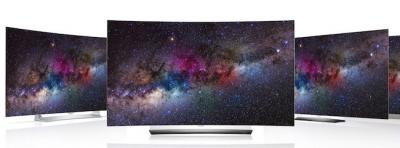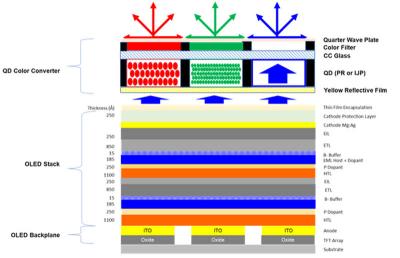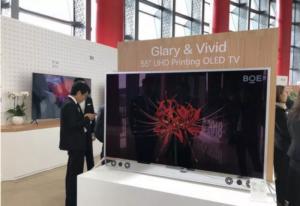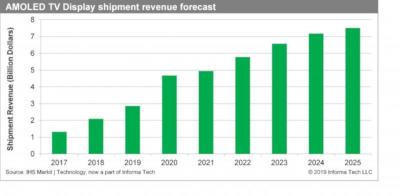This article is an extract from The OLED Handbook, 2020 edition, and gives a short introduction to the current OLED TV market status. The latest edition of the OLED handbook was published in March 2020.
LG Display
The OLED TV market is completely dominated today by LG Display, the only company that produces OLED TVs commercially. In 2013 both Samsung and LGD commenced production of OLED TVs, but Samsung quickly halted its OLED TV program to focus on Quantum-Dots enhanced TVs. In 2019 Samsung announced it is re-entering the OLED TV market and is set to build a QD-OLED production fab (more on this below).

LG Display adopted Kodak’s WRGB OLED technology (now owned by LG’s own GOT) and this technology, combined with oxide-TFT (IGZO) backplanes, enabled the company to economically scale up its large-area panel production. LG Display is producing 48 to 88 OLED TV panels, and is supplying its panels to several TV makers, including LGE, Sony, Panasonic, Philips and more.
LGD aggressively increases its OLED TV production capacity: LG shipped 1.4 million OLED TV panels in 2017, around 2.2-2.8 million panels in 2018 and likely around 3-3.8 million units in 2019. LGD aims to produce over 6 million panels in 2020 but note that it started to produce 48 panels for the first time, so average TV panel size may be lower in 2020.
LG Display currently has two 8.5-Gen OLED TV production lines in Korea, and LGD is finalizing a third 8.5-Gen line in Guangzhou, China where production costs will be lower as the fab is subsidized and labor is cheaper. LGD hoped to start mass production in Guangzhou in Q3 2019, but technical challenges delayed production, and LGD currently hopes that production will begin by Q2 2020. This may mean that LG’s OLED TV production plans for 2020 will not be realized.
LGD is also constructing a larger OLED production center in Paju the P10 fab that will produce OLED displays on 10.5-Gen substrates. The P10 building is almost complete but some reports suggest that LGD is postponing the fab construction as it is currently focusing on the Guangzhou fab.
Samsung
As previously mentioned, in 2013 Samsung Display produced commercial 55 OLED TV panels, but the company did not manage to scale up its RGB (direct-emission) LTPS production line to commercial volumes. Samsung stopped producing OLED TVs later, to focus on its Quantum Dots enhanced LCDs.

The success of LG’s OLED TV technology has forced Samsung to return to OLED technology. Samsung Is adopting a unique TV structure which is based on blue OLED emitters and quantum-dot color conversion films. There are two stacked blue OLED layers (based on evaporated fluorescence emitters) and the quantum-dots are printed using an ink-jet process.
While there are many technical challenges and problems with this design (for example the low-efficiency of the blue OLED emitter), Samsung is dedicated to this technology and in October 2019 SDC formally announced its decision to invest $10.85 billion in QD-OLED TV R&D and production lines in fact converting an existing LCD fab to QD-OLED production. SDC’s plan is to begin mass production in Q1 2021 although this could be delayed.
As of early 2020, Samsung’s premium TV strategy is based on three technologies, Quantum-Dots enhanced LCDs, QD-OLEDs and Micro-LED displays.
BOE Display
China’s BOE has a pilot Gen-8 OLED TV line in Hefei and the company demonstrated 55 4K OLED panel samples as early as 2014. In 2016 it was reported that BOE started low-volume commercial production and that Skyworth launched a new TV that uses these panels, but this was not confirmed and since then BOE did not update on its OLED TV line.
In early 2017 BOE Display announced that it signed an agreement with Hefei’s municipal government to co-invest $145 million USD in a new OLED TV production line in Hefei, which uses an ink-jet printing process (based on Kateeva’s equipment).

BOE inkjet-printed 55" 4K OLED TV (2018)
In November 2018 BOE unveiled its first ink-jet printed OLED TV prototype, the 55 4K panel you can see below. In November 2019 BOE demonstrate a 55 8K 400-nits OLED TV panel.
CSoT
TCL Subsidiary CSoT has an active OLED TV production project for many years, and as early as 2015 the company announced it believes future TVs will be based on printed OLED panels.
CSoT is building a TV fab (the 11-Gen T7 fab in Shenzhen) that will be used to produce both LCD and OLED TV panels. The OLED line will use an ink-jet printing process that’s CSoT’s current plan. CSoT started constructing the building towards the end of 2018, but we do not know its estimates for OLED TV production at the T7 line.
In 2016, CSoT (66%) and TianMa (34%) established a company called Guangdong Juhua Printing Display Technology as an open-innovation platform to develop ink-jet printing of OLED panels.
JOLED
Japan-based printed OLED developer JOLED is focused on medium sized OLED displays (mostly for monitors, laptops and signage), but the company has also developed OLED TV technologies. JOLED says that it has no aims to produce OLED TV panels at this stage, the TV technology was developed to demonstrate the company’s printing technology capabilities.
Towards the end of 2018 JOLED demonstrated its first OLED TV panel, a 55 4K panel that offers a 120Hz refresh rate.
OLED TV market forecasts
The OLED TV market is set to grow in the near future, but total capacity will still remain low compared to the entire TV market (which is estimated at over 250 million units), especially while LGD remains the only company to massively commit to OLED TV production.

Most display market analysts see steady growth for OLED TV production, basing their estimation on LGD as the single OLED TV producer, as it is not clear whether Chinese display makers will actually enter this market, and Samsung’s QD-OLED production plans are not known yet.
This was an extract from The OLED Handbook, 2020 edition. The book gives an introduction to OLED display and lighting - the technology, industry and market.
 Reading this book, you'll learn all about:
Reading this book, you'll learn all about:
- OLED technology, materials and production processes
- How OLEDs compare to LCD displays and LED lighting
- What kind of OLED panels are available on the market today
- What are the obstacles on the way for cheaper OLEDs
- OLED TVs, flexible, foldable and transparent OLEDs
- The future of OLED displays and lighting and challenges ahead
The OLED book also provides:
- A history of OLED development
- A guide to OLED investment
- A comprehensive list of OLED companies
- An introduction to other emerging display technologies (such as quantum dots and micro-LEDs)
- A list of existing and planned AMOLED fabs
- OLED lighting roadmaps

